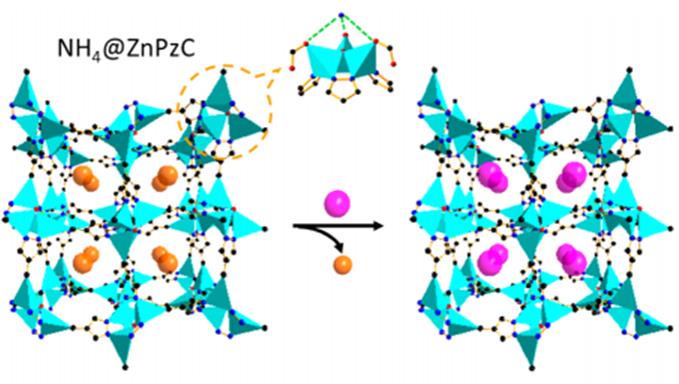
Jun-Hao Wang, Dong Luo, Mian Li, and Dan Li*

Abstract: This account demonstrates that under regulated synthetic conditions the protonated carboxyl sites in a neutral metal-organic framework (MOF), known as MOF-324 [formulated as Zn3OH(PzC)2(HPzC), H2PzC = 4-pyrazolecarboxylic acid], can undergo complete deprotonation, yielding NH4@ZnPzC [formulated as NH4·Zn3OH(PzC)3]. This modified, anionic framework with a pcu-g net is thus capable of postsynthetic cation exchange,which is highly modular, encompassing organic ammonium (Me3NH+, Et3NH+), main-group metal ions (Li+, Mg2+), and even lanthanide ions (Eu3+, Tb3+). The present approach is shown to be versatile and efficient in regulating porosity, fine-tuning gas adsorption properties, and endowing other functionalities such as liquid-phase adsorptive separation (benzene/cyclohexane). In particular, the selective adsorption behaviors of CO2 over N2 in this system have been studied in detail, targeting optimized CO2/N2 selectivity, which are evaluated through uptake capacity, isosteric heat, and ideal adsorbed solution theory. Besides the competent CO2/N2 selectivity (e.g., 50.8 for Li@ZnPzC at initial CO2/N2 = 15:85), the current approach, when compared with the popular strategy of amine-grafting on exposed metal sites, shows the advantages of (i) modular porosity and adsorption property, (ii) facile exchange processes which are quantifiable andwould not severely block the pore windows, and (iii) mild isosteric heat which is required for subsequent CO2 release. It is worthy to note the regulation of local deprotonation can be regarded as a general approach for MOF chemistry and functionalization, given that there are plenty of reported MOFs bearing such “open protonated sites”.
文章链接:![]() acs.cgd.7b00346.pdf
acs.cgd.7b00346.pdf




